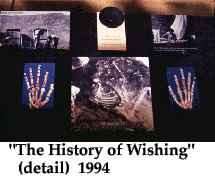

Gail Wight is a conceptual artist working with issues of cognitive science
(neurology, philosophy, artificial intelligence, and linguistics). Wight
received her MFA from the San Francisco Art Institute where she was a
Javits Fellow. Her work has been shown internationally, and she has
received numerous awards, including 1995 residencies at both Capp St.
Project and the Exploratorium. She lives and works in San Francisco, and is
currently an artist-in-residence at the Headlands Center for the Arts.
Artist's Statement:
 The combining of disciplines that caused the recent emergence of Cognitive Science philosophy, neurology, linguistics and artificial intelligence failed to engage the fine arts in any meaningful capacity. Maybe this is a fortuitous omission for artists, still free to observe, comment, and create outside of the often bizarre constraints of empirical science. It seems a dangerous omission, though, when societies look toward these sciences as potentially offering some "real" answers on the meaning of life.
The combining of disciplines that caused the recent emergence of Cognitive Science philosophy, neurology, linguistics and artificial intelligence failed to engage the fine arts in any meaningful capacity. Maybe this is a fortuitous omission for artists, still free to observe, comment, and create outside of the often bizarre constraints of empirical science. It seems a dangerous omission, though, when societies look toward these sciences as potentially offering some "real" answers on the meaning of life.

With this understanding, I've given myself the absurdist's task of looking for the gaps created by science and then cranking up the noise in the signal to see what emerges. Confusion about what's normal/abnormal cognition; how much of the body is brain; the interference run by il/legal drugs; whether a machine is more or less reliable due to its lack of endorphins, emotions, and opiate addictions; what something like compassion might actually look like at the neuroanatomical level; These are the sorts of questions that infect my thoughts and my story-telling, expressed in installation, computer, book and performance work.
In recent projects, I've been interested in "deep time," evolutionary aspects of cognition: an archaeological view of Neanderthal emotions, cerebral similarities with other species, the evolution of the brain's chemistry, and the cultural conception and history of genetics. Wherever science falls out of the empirical and lapses into the poetic, or simply ceases to make sense - this is the place where art begins for me.
Emotonilª

Belonging to the latest group of psychoactive pharmaceuticals, Emotonilª targets specific nuclei in the limbic system, neutralizing the local ionic charge and rendering the user emotionally dead for the duration.
While the lightbulb had been invented at the time when the synaptic gap was first being described, it wasn't yet in wide use. Therefore, the beautiful and enduring drawings of neurons under a microscope done by Santiago Ram—n y Cajal at the turn of the century were done by daylight, or perhaps candlelight.
Our development of "electronic media" has paralleled the growing comprehension of our own physiology as a system of electro-chemical processes. That Clipper Chips and the latest generation of anti-depressants have develop in tandem at the end of the twentieth century seems of no surprise. After all, phrenology and the telegraph grew up together in the early nineteenth century; and at the beginning of this century, intricate maps of the human nervous system proceeded in pace with the laying of power lines throughout city and countryside.
Emotonilª follows in this tradition. While most of us have lost our agrarian relationship to death, the mediated form is much more familiar. Lethal injection replaces the electric chair, doctor-assisted suicide survives the judicial system, laser and radioactive surgical procedures pinpoint death down to nuclei and layers of cells, and tailored viruses lice our own DNA. Capitalizing on our biological processes helps keep the stock exchange alive, while "brain-power" becomes the buzzword of the commodities industry.
Why not, in the midst of developing our latest generation of smart machines, choose a brief respite from the biological nuisance of emotions, and take advantage of the temporary emotional death offered by Emotonilª?
 back...
back...



 The combining of disciplines that caused the recent emergence of Cognitive Science philosophy, neurology, linguistics and artificial intelligence failed to engage the fine arts in any meaningful capacity. Maybe this is a fortuitous omission for artists, still free to observe, comment, and create outside of the often bizarre constraints of empirical science. It seems a dangerous omission, though, when societies look toward these sciences as potentially offering some "real" answers on the meaning of life.
The combining of disciplines that caused the recent emergence of Cognitive Science philosophy, neurology, linguistics and artificial intelligence failed to engage the fine arts in any meaningful capacity. Maybe this is a fortuitous omission for artists, still free to observe, comment, and create outside of the often bizarre constraints of empirical science. It seems a dangerous omission, though, when societies look toward these sciences as potentially offering some "real" answers on the meaning of life.

 back...
back...